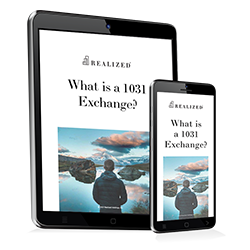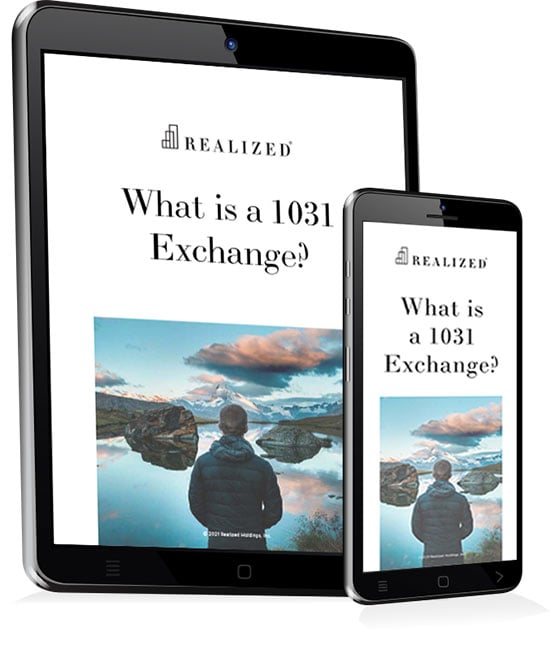
Deferring capital gain taxes is a widely used strategy that helps investors preserve their funds as they diversify into new sectors or niches. Among the many tax-deferral methods you can leverage, two of the most popular options are 1031 exchanges and Opportunity Zones.
A 1031 exchange allows investors to defer taxes through successive exchanges by reinvesting in like-kind properties, while Opportunity Zones offer tax deferrals until 2026 (and a potential tax-free appreciation benefit after ten years).
These two strategies have distinct benefits and processes that investors should understand before choosing between them. Below, Realized 1031 has shared a guide comparing the two to give you a more in-depth idea of which is best for you.
The Basics of 1031 Exchanges
Named after Section 1031 of the Revenue Code, the 1031 exchange is a tax-deferral strategy where you exchange a like-kind property that is for investment or business use for another. Since no sale occurs, there is no taxable event. Since there is no taxable event, the capital gains from the sale of the relinquished property are deferred until a triggering sale occurs.
The IRS imposes a few rules for 1031 exchanges to avoid abuse of the process, which include the following:
- Like-kind requirement: The assets must be real property held for investment or business use.
- 180-day timeline: The IRS requires the entire transaction to be completed within 180 days, with 45 days allotted for identifying the replacement property.
- Arm’s-length transaction: Investors cannot have direct control of the proceeds from the sale of the relinquished property. As such, a qualified intermediary is required.
When structured in accordance with IRS rules, 1031 exchanges provide more than just tax-deferral benefits. This strategy allows investors to diversify their portfolios. Plus, heirs may receive a step-up in basis in the context of estate planning, potentially eliminating capital gains taxes. However, actual tax treatment depends on individual circumstances, and investors should consult qualified tax and legal professionals to evaluate potential outcomes.
The Basics of Opportunity Zones
The other popular tax-deferral strategy is investing in a Qualified Opportunity Zone (QOZ). The Opportunity Zone program came about after the Tax Cuts and Jobs Act of 2017, and it’s meant to encourage investors to place their capital in designated census areas. These locations are usually in economic distress, and the funds from investors can help them develop.
Investing in Opportunity Zones is highly regulated, with rules such as the following:
- Investors must reinvest eligible capital gains into a qualified opportunity fund (QOF) within 180 days of realizing the gain.
- The QOF must invest in a business, property, or development located in the QOZ.
- To maximize tax benefits, the investment should be held for at least 10 years.
When you invest in a QOZ, the capital gains from your previous property will remain deferred until December 31, 2026. Your fund will grow, meanwhile, as the QOF earns income from the properties it invested in. If held for 10+ years, appreciation on the investment is completely tax-free.
Comparing Tax Deferral Benefits and Risks
The primary appeal of both 1031 exchanges and QOZs is their tax deferral benefits. How do they compare to each other? Here are some key differences you should be aware of.
1031 Exchanges
A 1031 exchange allows investors to defer capital gains taxes through successive exchanges indefinitely. This means that as long as you continue reinvesting the proceeds into another like-kind property for investment or business use, you defer paying capital gains taxes. There is no limit on the number of exchanges an investor can complete. You can keep rolling over gains into new properties, deferring taxes indefinitely and potentially eliminating them if you hold the property until death, thanks to the step-up in basis benefit.
While 1031 offers powerful tax-deferral benefits, investors remain liable for capital gains tax if the property is sold in a taxable transaction, or if boot (non-like-kind property or cash) is received. The strategy requires strict adherence to IRS timelines, usage rules, and documentation standards. Investors should consult with qualified tax and legal professionals to evaluate their specific circumstances.
QOZ
There are limitations for QOZ as you can only defer capital gains taxes until December 31, 2026, or until you sell the QOF investment — whichever comes first. The definitive deadline stems from the fact that the Tax Cuts and Jobs Act of 2017 included sunset provisions that expire at the end of 2027.
However, the biggest advantage of a QOZ investment is the potential for for federal capital gains exclusion on the appreciation of the QOF investment itself.. If an investor holds the Opportunity Zone investment for at least 10 years, any gains realized from the appreciation of that investment are entirely tax-free.
QOFs are subject to regulatory complexity, including compliance with the 90% asset test, restrictions on investment type, and varying state tax conformity. The performance of the underlying Opportunity Zone investments may be affected by market risk, liquidity constraints, and development or business risks, and returns are not guaranteed.
These characteristics make each option suitable for certain investors, depending on their tax goals and investment horizon. For example, QOZs may appeal to those who intend to exchange only once, expecting to pay capital gains taxes later. Meanwhile, those who intend to continuously defer their capital gains taxes will naturally find 1031 exchanges the more viable strategy.
Investment Opportunities
The next point of comparison to discuss is the types of properties you can invest in for each option.
- 1031 Exchange: You are limited to only real property held for investment or business purposes. Like-kind assets include apartments, commercial properties, farmland, and industrial properties.
- QOZ: Investment opportunities are broader in QOZ, as QOFs are allowed to invest in businesses. However, you are limited to assets that are located within the Opportunity Zone. The QOF is not allowed to invest outside of these designated areas.
Investment Vehicle
Both 1031 exchanges and QOZs require specific investment vehicles to facilitate the transaction. Here are the key differences.
- 1031 Exchange: The proceeds from the sale of the relinquished property are transferred to the qualified intermediary. This requirement prevents the creation of a constructive receipt, which is a taxable event. The qualified intermediary will hold the funds in escrow until you find and acquire a suitable replacement property.
- QOZ: The QOF serves as the investment vehicle for QOZs. The fund then pools the money and uses it to purchase, renovate, and operate assets within the QOZ.
Source of Income
Both QOZ and 1031 exchange investments earn income through similar means. However, there are a few differences that investors may want to consider.
- 1031 Exchange: Given how the eligible assets in a 1031 exchange are mostly real estate property, income usually comes from real estate-related activities. These include rental income and property appreciation.
- QOZ: QOZ investments can also profit from real estate-related activities. However, since businesses are included in QOZs, investors can enjoy greater diversification. This advantage can be especially significant if the sector the business belongs to sees significant growth.
Timeline Comparison
Timing plays a crucial role in both 1031 exchanges and Opportunity Zone investments. While both follow 180-day deadlines, there is one key difference.
- 1031 Exchange: Investors must identify a replacement property within 45 days of selling their original property and complete the transaction within 180 days.
- QOZ: Investors must reinvest capital gains into a QOF within 180 days of realizing the gain. Unlike a 1031 exchange, there is no 45-day identification rule. The lack of this deadline provides a longer timeframe for the QOF managers to find suitable properties.
Minimum Investment Required
Another point of comparison for 1031 exchanges and QOZs is the minimum investment required.
- 1031 Exchange: Based on IRS rules, you must find a property that has equal or greater value than the one you relinquished. This is because all proceeds from property sales must be reinvested for full tax deferral. In other words, the minimum investment required is all of the proceeds.
- QOZ: Investors can reinvest any portion of their capital gains into a QOF. There is no requirement to reinvest the entire sale proceeds. Only the gains must be reinvested to qualify for tax benefits. Even so, some QOFs will impose a minimum, so make sure you’re aware of their threshold.
Location of Eligible Properties
The locations of properties that qualify for 1031 exchanges and Opportunity Zone investments differ significantly.
- 1031 Exchange: You can exchange into a property held for investment purposes anywhere in the U.S. However, properties in U.S. territories do not count.
- QOZ: QOFs are limited to Opportunity Zones only, but these designated areas aren’t just located within the U.S. states. There are some U.S. territories with QOZs, which allow inventors to invest in designated economically distressed areas within those territories, providing a wider geographical scope than just the 50 states.
Tax on Appreciation
One final consideration when deciding between 1031 exchanges and QOZs is how properties are taxed on appreciation.
- 1031 Exchanges: Appreciation will not be taxed until a triggering event occurs, such as a sale. If you hold the property until your passing, it will have a step up in basis, eliminating the tax burden for your heirs. However, if you sell the asset while living, you will be liable to pay taxes on appreciation plus the capital gains taxes you deferred.
- QOZ: If an investor holds the QOZ investment for at least 10 years, any gains from the appreciation of that investment may be excluded from federal capital gains tax. This exclusion applies only to gains realized on the QOF investment itself, not to the original deferred capital gain, which must be recognized no later than December 31, 2026.
Wrapping Up: Qualified Opportunity Zone vs. 1031 Exchange
Choosing between QOZs and 1031 exchanges can be tricky, especially for investors who have yet to try a tax-deferral strategy. Each option has its own rules, advantages, and challenges you’ll want to keep in mind to choose one that fits your investment goals and risk profile.
For professional guidance and resources regarding each option, we’re here to help. Contact Realized 1031 today to learn more about each strategy.
The tax and estate planning information offered by the advisor is general in nature. It is provided for informational purposes only and should not be construed as legal or tax advice. Always consult an attorney or tax professional regarding your specific legal or tax situation.
Sources:
https://www.investopedia.com/taxes/trumps-tax-reform-plan-explained/
https://www.irs.gov/credits-deductions/businesses/opportunity-zones



